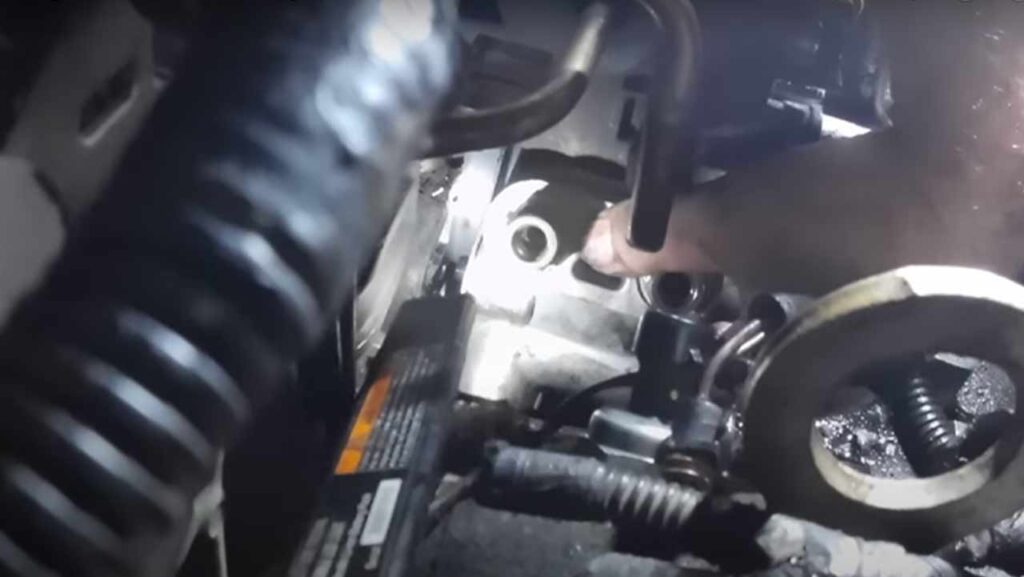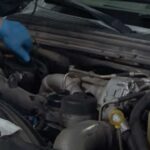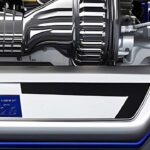To change the HPOP on a 7.3 Powerstroke, you will need to first drain the oil from the engine and disconnect all electrical connectors related to it. Remove any brackets or hoses connected to it. Next, use a wrench to remove the bolts that attach the HPOP reservoir to its mounting bracket and carefully lift it off of its mount.
Take out any remaining o-rings, gaskets, and seals before installing your new unit in their place. Make sure everything is fully tightened and reconnected before refilling with clean oil per manufacturer’s recommended specifications. Be sure to start up your truck after installation in order to check for proper function before driving it anywhere!
- Step 1: Locate the HPOP reservoir on the driver side of the engine block
- This is a small, black plastic container that houses the high-pressure oil pump and its related components
- Step 2: Unbolt and disconnect any hoses or wires attached to the HPOP reservoir
- Step 3: Remove all bolts from around the perimeter of the HPOP reservoir using a socket wrench
- Once all bolts have been removed, carefully remove it from its mounting location on top of the engine block
- Step 4: Install your new HPOP in place by first inserting it into its mount and then securing it with all previously removed bolts
- Make sure each bolt is tightened evenly until they are snugly secured against one another but not over-tightened as this may cause damage to both parts and surrounding areas of your engine block
- Step 5: Reconnect any disconnected hoses or wires according to their appropriate locations, ensuring that no connections are left unreconnected or cross connected (i
- ,e connecting two different types of hose ends together)
- Once done, double check that everything has been securely reconnected before starting up your vehicle again for testing purposes
7.3 High Pressure Oil Pump Symptoms
If your vehicle is equipped with a 7.3 high pressure oil pump, then you should be aware of the common symptoms that can occur when it malfunctions. Some signs to look out for include excessive engine noise, reduced fuel economy, black smoke from the exhaust pipe, and difficulty starting the engine. If you experience any of these issues while driving your car or truck, it’s essential to have the issue checked out by a professional mechanic as soon as possible in order to prevent further damage to your vehicle.
7.3 Hpop Replacement Time
Replacing your 7.3 HPOP can be a time consuming, yet necessary task to ensure the proper functioning of your vehicle. Replacement generally takes 4-5 hours of labor, and it is usually recommended that you have the oil pan gasket replaced at this time as well since it will need to be removed for removal and installation of the HPOP. It’s also extremely important during replacement to make sure that all parts are properly lubed with clean engine oil before assembly, as any debris could cause serious damage down the road.
7.3 Hpop Removal
Removing the 7.3 HPOP (High Pressure Oil Pump) can be a complex and time consuming job for even experienced mechanics, so it is not recommended to attempt this repair on your own unless you have extensive knowledge of diesel engine mechanics. The HPOP is responsible for providing oil pressure throughout the system and if it fails, serious damage can occur to other components in the vehicle. Therefore, when removing the 7.3 HPOP, it’s important that all safety guidelines are followed and any necessary tools are at hand before beginning.
7.3 Hpop Rebuild Or Replace
When it comes to repairing a 7.3 HPOP, the answer is not always clear cut. Depending on its condition and how long you plan to keep your Ford Powerstroke engine, you may want to consider either rebuilding or replacing the High-Pressure Oil Pump (HPOP). Rebuilding will usually be less expensive than buying a new unit while also extending the life of existing components.
However, if your 7.3 HPOP is severely damaged or has reached its limit of use then replacing it with a brand-new part may be more cost effective in the long run. Ultimately, it’s important to assess the situation and make an educated decision that best fits your needs.
7.3 Powerstroke High Pressure Oil Pump Location
The 7.3 Powerstroke high pressure oil pump is located on the driver’s side of the engine block and is driven off a dedicated camshaft lobe. This pump is responsible for pressurizing the fuel system, which in turn helps to provide more power and efficiency from your engine. To ensure that this vital component remains in proper working order, it’s important to check the oil level regularly and replace any worn or damaged parts as soon as possible.
What Happens When Hpop Fails?
When the High Pressure Oil Pump (HPOP) fails in a diesel engine, it can cause a number of problems. Without an adequate supply of high pressure oil to operate the injectors, the engine will not run correctly or at all. Additionally, if there is too much oil entering the cylinders during compression stroke, excess blow-by gas may be produced and cause air pollution issues.
If HPOP failure is severe enough, it can also damage other components of the fuel system such as injection lines and injector nozzles. Furthermore, when HPOP fails, it usually causes an increase in fuel consumption that results in decreased performance and reduced fuel economy. In some cases, major overhauls may be required to repair any damages caused by HPOP failure; this work must be done by authorized personnel with appropriate knowledge about diesel engines and their systems.
To avoid possible HPOP failures before they occur, regular maintenance should include checking for leaks around hoses connected to the pump as well as inspecting its filter for debris buildup which could prevent proper operation over time.
How Do I Know If My High Pressure Oil Pump is Bad?
If you own or drive a diesel engine, it is important to know if your high pressure oil pump (HPOP) is working properly. The HPOP pressurizes the fuel rail, which allows for fuel injection into the combustion chamber. When this is not functioning correctly, it can cause a variety of problems with your vehicle such as poor idle performance, lack of power and even stalling.
Fortunately, there are several ways to check whether or not your HPOP is bad.
First off, listen for any strange noises coming from the engine bay when starting and running the car. If you hear loud clicking noise that sounds like metal on metal contact then chances are that your HPOP needs replacement or repair.
Secondly look at your diagnostic codes; if you have an OBD II scan tool than most likely any error codes related to low oil pressure will be displayed indicating an issue with the pump itself. Lastly inspect all visible components including hoses and fittings associated with the pump – they should be connected firmly without signs of seepage or wear around them which would suggest a faulty seal inside the unit itself..
What is Normal Pressure for 7.3 Hpop?
The normal pressure for a 7.3 High Pressure Oil Pump (Hpop) is approximately 1000-1500 psi at idle, and should increase to around 1800-2500 psi when the engine is under load or running at higher RPMs. It is important to check the Hpop pressure regularly using a specialized tool to make sure that it is operating within these parameters as this can help avoid damage due to inadequate oil flow, particularly in high performance applications. Additionally, incorrect oil pressure can be an early indicator of other potential issues such as failing injectors or worn out seals which may cause further damage if left unchecked.
How Do You Drain the Hpop on a 7.3 Powerstroke?
Draining the HPOP (High Pressure Oil Pump) on a 7.3 Powerstroke diesel engine is an important maintenance procedure that should be performed at regular intervals to ensure optimal performance and fuel economy. The HPOP is responsible for pressurizing the oil in order to provide lubrication to the injectors, so if it’s not properly maintained it can lead to decreased power, poor fuel efficiency and even catastrophic engine failure. Luckily, draining the HPOP on a 7.3 Powerstroke isn’t too difficult of a job; all you need are some simple tools and about 30 minutes of your time.
To start off, remove the air intake tube from behind the grille and then locate the oil filter housing – this is where you will find both your primary and secondary high pressure pumps. Next up, use either an 8mm socket or wrench to loosen up each pump’s drain plug before going ahead and removing them completely; once these have been removed, allow all of the oil inside each pump reservoir to fully drain out into a container or pan below it before replacing both plugs back into their respective housings using fresh thread sealant like Loctite 592 or similar products recommended by Ford Motor Company themselves. Finally, reinstall your air intake tube just as before with those same tools used earlier – And that’s how easy it is!
Just remember: while draining your HPOP may seem like a big hassle at first glance; in reality taking care of this critical component regularly can end up saving you tons of money down line in terms of costly repairs or replacements later on – So don’t delay any longer!
Replacing the High Pressure Oil Pump (HPOP) on a 7.3 Powerstroke Ford F-250 Superduty
Conclusion
Changing the HPOP on a 7.3 Powerstroke is not an easy task, but with the right tools and knowledge it can be done quickly and efficiently. It is important to follow all of the necessary steps when replacing your HPOP, such as ensuring that you have all of the correct parts for installation, draining out any remaining oil in the system before attempting to remove components, and torquing down bolts correctly. If followed carefully, changing your HPOP can help keep your truck running smoothly while avoiding costly repairs in the future.

Hi, I’m Kermit L. Williams, and I’ve spent the better part of my life immersed in the world of automobiles, with a particular passion for Powerstroke engines. As an automotive expert, I’ve spent countless hours tinkering with engines, testing products, and sharing my knowledge with other enthusiasts.
Through my work on PowerstrokeGuides.com, I aim to share that knowledge with others and help them make informed decisions about their automotive purchases and maintenance. Whether you’re a seasoned Powerstroke enthusiast or just starting out, I’m here to provide you with the insights and expertise you need to take your vehicle to the next level.







